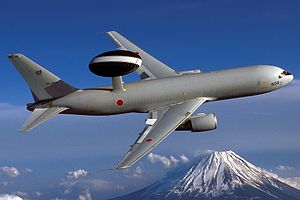Boeing E-767
| E-767 | |
|---|---|
 |
|
| Boeing E-767 AWACS aircraft of the JASDF | |
| Role | Airborne Warning and Control System (AWACS) |
| Manufacturer | Boeing IDS |
| First flight | 4 October 1994 (without rotodome) 9 August 1996 (with rotodome) |
| Introduction | 10 May 2000 |
| Status | In service |
| Primary user | Japan Air Self-Defense Force |
| Number built | 4 |
| Developed from | Boeing 767 |
The Boeing E-767 is an Airborne Warning and Control System (AWACS) aircraft. It was designed in response to the Japan Air Self-Defense Force's requirements, and is essentially the Boeing E-3 Sentry's surveillance radar and air control system installed on a Boeing 767-200.
On September 6, 1976, Soviet Air Force pilot Viktor Belenko successfully defected to the West, flying his MiG-25 'Foxbat' to Hakodate, Japan. During this incident, Japan Self-Defense Force radar lost track of the aircraft when Belenko flew his MiG-25 at a low altitude, prompting the Japan Air Self-Defense Force (JASDF) to consider procurement of airborne early warning aircraft.
In 1976, the U.S. Air Force was about to deploy the E-3 Sentry airborne warning and control system aircraft, which was considered to be the prime candidate for the airborne early warning mission by JASDF. However, the Japan Defense Agency (JDA, now Ministry of Defense) realized that the E-3 would not be readily available due to USAF needs and instead opted to procure the American E-2 Hawkeye AWACS aircraft. The E-2C was put into service with the Airborne Early Warning Group (AEWG) at JASDF Misawa Air Base in January 1987.
In 1991, the JDA requested funds to upgrade the airborne early warning system by procuring the E-3. Unfortunately, production of the Boeing 707-based E-3 airframe had ended in 1991 and the plan was shelved. The following year, Boeing proposed a 767-based AWACS, and the JDA agreed to procure two E-767 in fiscal year 1993 and two more in fiscal year 1994.
JDA requested a budget of JPY113.9 billion to procure two E-767s in fiscal year 1993 and JPY108.1 billion for two more E-767s in FY 1994. This large budget compared to approximately JPY8.6 billion for the E-2C and an estimated JPY29.6 billion for the E-3A was politically rationalized as a means to help ease the tension over Japan's large trade surplus against the U.S. In addition, Japanese aerospace companies are responsible for 15% of the airframe production for the 767, meaning some of the money would indirectly return to Japan.
...
Wikipedia
